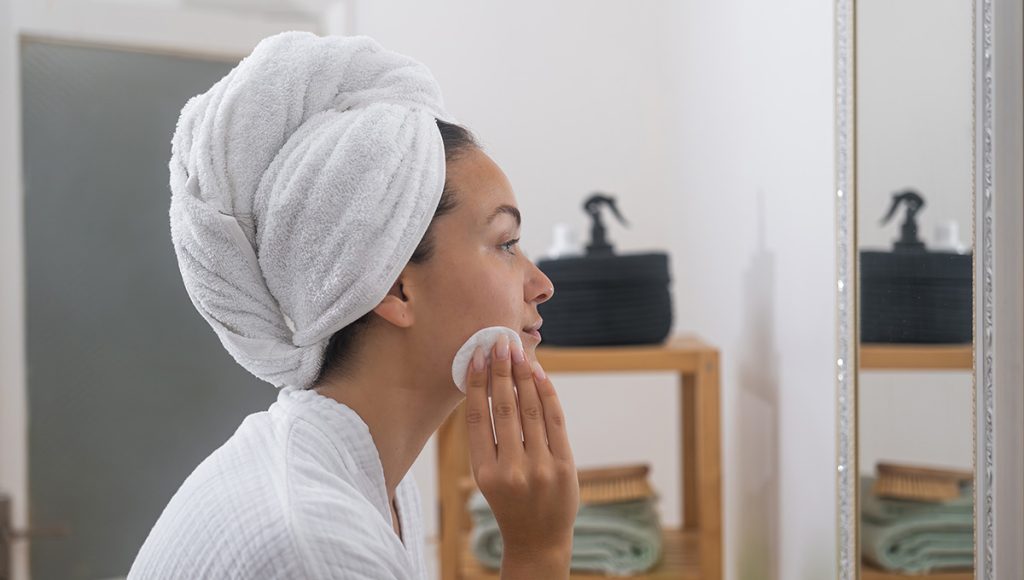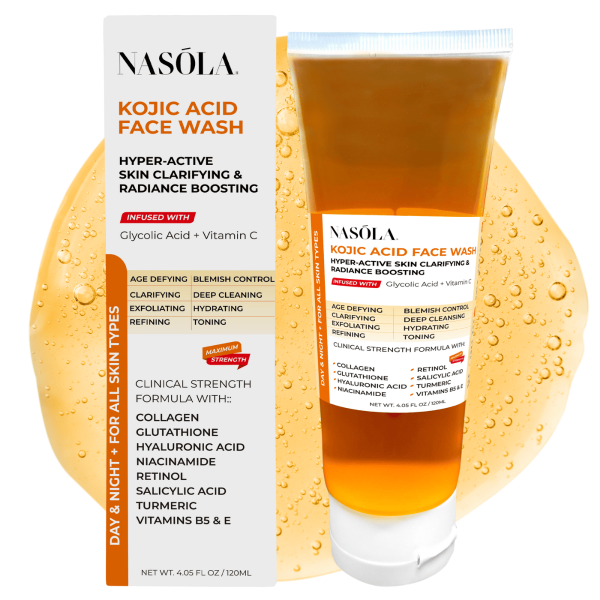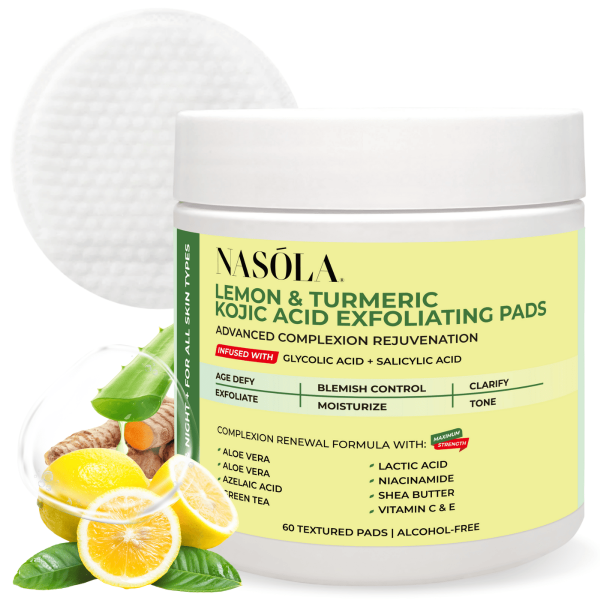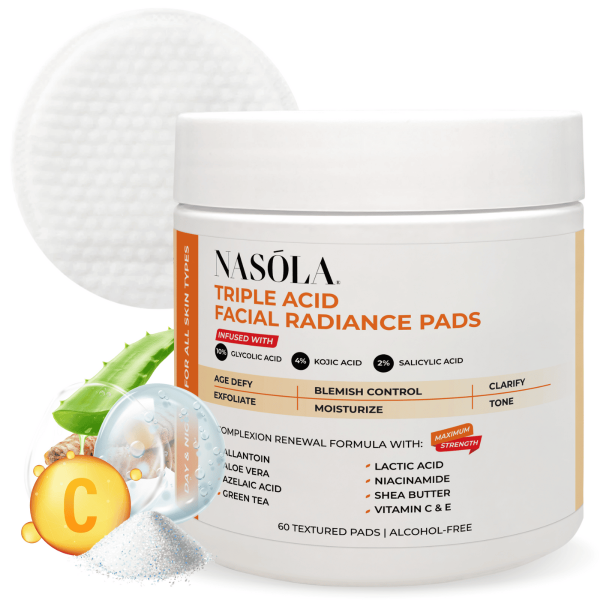Using the best face wash to use with tretinoin can honestly make or break your skin journey.
When I first started tretinoin, I was all in—ready to zap away every last dark spot, acne scar, and fine line. Until… my face turned into a flaky, irritated mess.
That’s when I learned, the hard way, that this miracle cream needs the right support act. Choosing the wrong cleanser? It can throw your moisture barrier into chaos—and nobody wants that.
In this blog, we’re talking not just about avoiding irritation, but about enhancing results—think even tone, smooth texture, fewer breakouts.
And yes, I’ll be dropping some morning-routine gold and why your cleanser’s pH matters big time. You’re also going to meet a few of my skin-saving staples, like the Nasola Kojic Acid Face Wash, Nasola Triple Acid Facial Radiance Pads, and Nasola Lemon Turmeric Kojic Acid Exfoliating Pads.
So grab your favorite tea… we’re diving deep into glow-up mode.
What Face Wash to Use with Tretinoin?
Tretinoin is like your skin’s overachiever friend—it speeds up cell turnover, clears acne, and smooths wrinkles. BUT, it also makes your skin more vulnerable.
That’s why choosing what face wash to use with tretinoin matters. You need a cleanser that’ll do its job without causing chaos.
The best cleansers for tretinoin users are gentle, non-stripping, and packed with hydrating and barrier-supporting ingredients.
Let’s break down what to look for, what to avoid, and how to make your cleanse complement your glow-up game.
Look for Sulfate-Free, Fragrance-Free Formulas
If you’re tossing tretinoin on top of a face that’s been wiped out by a harsh, fragrance-loaded cleanser? Yikes. That’s just begging for redness and peeling.
Gentle, sulfate-free formulas are your friend. Fragrance-free? Even better. You don’t want your cleanser competing with tretinoin or making your skin more reactive than it already is during those early adjustment weeks.
Ingredients like aloe, chamomile, or oat extract help soothe angry skin, while hydrating agents like glycerin and panthenol deliver comfort during each cleanse.
Here’s why fragrance-free and sulfate-free matter:
- Protects the skin barrier during the retinoid-induced adjustment period
- Minimizes irritation and redness already sparked by tretinoin
- Encourages consistent use by making routines soothing instead of painful
- Pairs well with sensitive skin regimens, especially AM/PM cleansing cycles
Switching to something gentle might seem small, but your future smooth, calm skin will thank you.
Hydrating Ingredients Like Glycerin, Hyaluronic Acid, and Ceramides Support the Skin Barrier
Now let’s talk moisture. 🔥
Your skin is already dealing with flakes and dryness from tretinoin, so a hydrating face wash doesn’t just help—it’s essential. Think of glycerin and hyaluronic acid as your skin’s best hydration tag team.
Ceramides? Total MVPs. They help patch up tiny cracks in your skin barrier and keep moisture locked in.
Stack the benefits:
- Glycerin deeply draws in moisture, even in dry climates
- Hyaluronic acid boosts plumpness by holding up to 1,000x its weight in water
- Ceramides reinforce your barrier, preventing water loss and flakiness
- Panthenol (pro-vitamin B5) calms skin and improves softness
The result? Skin that feels less tight, less itchy, and more supple.
Exfoliation is important—but keeping your skin barrier happy outranks almost everything else when you’re using tretinoin.
Exfoliation Is Key—But Needs to Be Balanced

Alright, here’s where things get a little more delicate. Yes, exfoliation is still part of the glow-up, but when tretinoin is already making your skin shed… you don’t want to overdo it.
So what’s the happy middle ground? It’s about choosing chemical exfoliation over harsh scrubs and using those acids sparingly.
That way, you’re gently removing dead skin instead of ripping open your barrier. SO??? Let’s exfoliate smart, not reckless.
Alpha Hydroxy Acids (AHAs) and Beta Hydroxy Acids (BHAs) Can Stimulate Cell Turnover
If skin science had a language of love, AHAs and BHAs would be writing sonnets with tretinoin. Glycolic, lactic, and salicylic acid are chef’s kiss when used just right.
Apply exfoliating products 1–2 times a week to:
- Loosen and remove dead skin, promoting smoother texture
- Clear out clogged pores, especially blackheads
- Prevent buildup from causing breakouts (common with retinoid purging)
- Brighten complexion, giving you that “just-glowed” radiance
Introducing the Nasola Triple Acid Facial Radiance Pads into your routine can be game-changing. They blend glycolic, lactic, and salicylic acids in a pre-soaked pad—ZERO mess, MAX precision.
These are gentle enough that they support your glow while still respecting your tretinoin routine.
Use once a week at first… your face will thank you later.
Use Chemical Exfoliators Sparingly to Avoid Tretinoin Irritation
Let me tell you from experience: over-zealous exfoliating + tretinoin? Recipe for redness, flaking, and regret.
Start slow. Use chemical exfoliators:
- No more than 1–2 times per week during the first month of tretinoin
- At night, but not on the same night as your tretinoin application
- Only after cleansing, and always follow with a gentle moisturizer
- Watch for increased sensitivity, redness, or stinging
Better yet, rotate with Nasola Lemon Turmeric Kojic Acid Exfoliating Pads. These pads use kojic acid, turmeric, and lemon extract to brighten and calm down reactive skin while still refining texture.
Even better? They smell like magic without using synthetic fragrances. Safe for acne-prone and melanin-rich skin.
Best Face Wash to Use with Tretinoin to Avoid Irritation
When your skin’s on edge, your cleanser becomes your peacekeeper. This section is for everyone asking: what is the best face wash to use with tretinoin that won’t trigger World War III on my face?
We’re going into pH balance (don’t worry, I’ll keep it real), low-lather formulas, and one product that combines gentle cleansing with brightening… without drama.
Neutral pH Products Prevent Skin Barrier Disruption
Let’s simplify:
Your skin likes a slightly acidic pH (around 4.5–6). Most foaming, stripping cleansers? Way too alkaline. That means they dry you out, imbalance your microbiome, and undo all your skincare progress.
Here’s what a neutral pH cleanser offers:
- Supports your skin’s natural moisture barrier and microbiome
- Prevents that “tight,” squeaky feeling after rinsing
- Reduces risk of breakouts, irritation, and peeling
- Keeps your hydration + retinol efforts working together, not in conflict
Low pH = less inflammation. Period.
Low-Lather Formulas Reduce Dryness Caused by Tretinoin
A little foam is fine. Tons of lather? Usually means sulfates or surfactants that strip your skin.
Switching to a low-lather, creamy cleanser means less dryness, fewer flakes, and more balance.
That’s where Nasola Kojic Acid Face Wash shines. It’s sulfate-free, pH-balanced, and gentle enough for daily use. Plus, it contains kojic acid—a brilliant natural exfoliant that targets melanin production. That means fewer dark spots and a balanced skin tone.
Why you’ll love it:
- Kojic acid brightens without bleaching
- No harsh foaming agents = less irritation
- Works wonderfully with sensitive or acne-prone skin
- Feels rich and calming—even during winter dryness
Your night routine doesn’t have to feel like damage control anymore.
Incorporating Exfoliating Pads While Using Tretinoin

Alright, exfoliating pads? Amazing. But timing and technique really matter when combining them with tretinoin. Let’s talk spacing, sensitivity, and how to sneak them in without triggering skin freakouts. Because glow is the goal, not tears.
Limit to 1-2 Times Weekly to Avoid Over-Exfoliation
Start cautiously and ramp up based on how your skin reacts. Over-exfoliation is one of the main reasons tretinoin users backslide into redness and texture issues.
Stick to these rules:
- Use pads on nights you skip tretinoin
- Rotate between different acid blends (like radiance vs. brightening)
- Only exfoliate after gentle cleansing
- Watch your skin’s reaction post-exfoliation
The Nasola Triple Acid Facial Radiance Pads are amazing for beginners because they’re clearly labeled, evenly dosed, and free from alcohol—no sting, just glow.
Put the cotton rounds down more than you pick them up. Overdoing it won’t get you results faster—it’ll just earn you a one-way ticket to Inflamed City.
Monitor Your Skin’s Tolerance First Before Adding Acids
Your skin will speak to you. Listen 👂🏽
When you’re new to tretinoin, stick to the basics first. Hydration and barrier repair take priority. Then, as your skin becomes more resilient, slowly introduce exfoliation.
A perfect starting point is the Nasola Lemon Turmeric Kojic Acid Exfoliating Pads. These are:
- Infused with turmeric for calming inflammation
- Loaded with kojic acid to fade dark patches
- Enhanced with lemon extract for natural clarity
- Gentle on melanin-rich and reactive skin types
No tingling frenzy. Just subtle brightness, smoother texture, and a balanced glow that works with your tretinoin.
(And yes, the pads are pretty photogenic too.)
BONUS: What to Avoid in a Face Wash When Using Tretinoin
You know what not to put in a smoothie… same trick applies to skincare. There are definite NOs when choosing the best face wash to use with tretinoin. Skip these, and your skin will thrive.
Alcohols, Scrubs, and Astringents = Skin Sabotage
You don’t need to feel a burn to know something’s working. It’s 2024—we’re smarter than that.
Avoid these face wash ingredients like your ex on a bad day:
- Denatured alcohol/ethanol: Instant dehydration
- Benzoyl peroxide: Too drying next to tretinoin (save for alternate routines)
- Physical scrubs: Microtears? Absolutely not with sensitive skin
- Strong astringents (witch hazel, high % tea tree): Strip and sting
Instead? Hydrate. Balance. Calm. Glow. Then let tretinoin do its thing overnight.
Choosing Cleansers That Support Results, Not Undo Them
Your cleanser sets the tone. Using something packed with soothing ingredients helps tretinoin perform its magic without unnecessary drama.
Look for:
- Creamy textures with soft emulsifiers
- No artificial dyes or fragrances
- Lipids or fats (yes, even in cleansers) to buffer actives
- pH-balanced or low-pH labels
When your cleanser plays nice, your retinoid doesn’t have to “fight” anymore. Let it transform instead.
Frequently Asked Questions
The Nasola Kojic Acid Face Wash is a great pick. It’s sulfate-free, gentle on delicate complexions, and infused with kojic acid to softly brighten dark spots without irritating sensitive skin.
Yes, but moderately. The Nasola Triple Acid Facial Radiance Pads are ideal for 1–2 weekly use. Just make sure you NEVER use them on the same night as tretinoin to avoid over-exfoliation.
Absolutely. Cleansing removes oils and impurities, helping tretinoin absorb evenly. Use a gentle option like the Nasola Kojic Acid Face Wash to prep your skin without stripping it.
Yes, they pair wonderfully. Kojic acid helps fade dark spots while tretinoin speeds up cell turnover. Use products like Nasola Lemon Turmeric Kojic Acid Exfoliating Pads on non-tretinoin nights for best results.
Expect redness, peeling, and possible breakouts. Harsh cleansers strip your skin barrier, making it harder for tretinoin to do its job. A soothing cleanser like the Nasola Kojic Acid Face Wash ensures your actives work in harmony.
Pads like the Nasola Triple Acid Facial Radiance Pads promote cell renewal and remove buildup—resulting in clearer, smoother, and brighter skin over time.
Switch to a pH-balanced face wash, and avoid using leave-on exfoliants the same nights you apply tretinoin. Moisturize afterward to lock in hydration and reduce peeling.
In raw form—no. In formulated skincare like the Nasola Lemon Turmeric Kojic Acid Exfoliating Pads, absolutely. The pH is balanced, and additional ingredients soothe potential irritation.
100%! Hyperpigmentation, dullness, and acne scarring don’t discriminate. Kojic acid in products like Nasola Kojic Acid Face Wash is effective for all skin types and tones—men included.
You’re probably using a cleanser that’s too harsh or contains alcohol/fragrance. Swap it with the Nasola Kojic Acid Face Wash, and monitor the difference. Stinging = irritation, not effectiveness.




